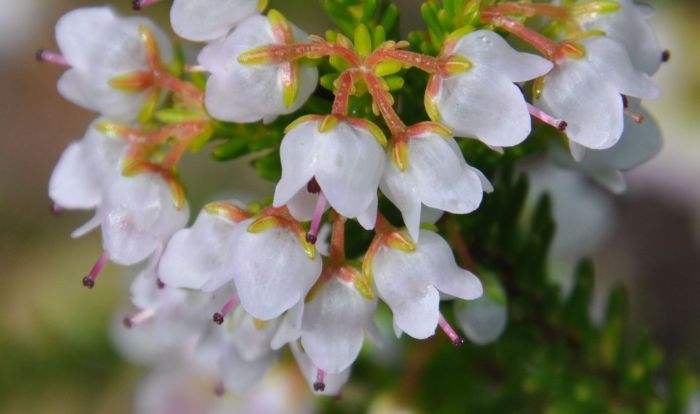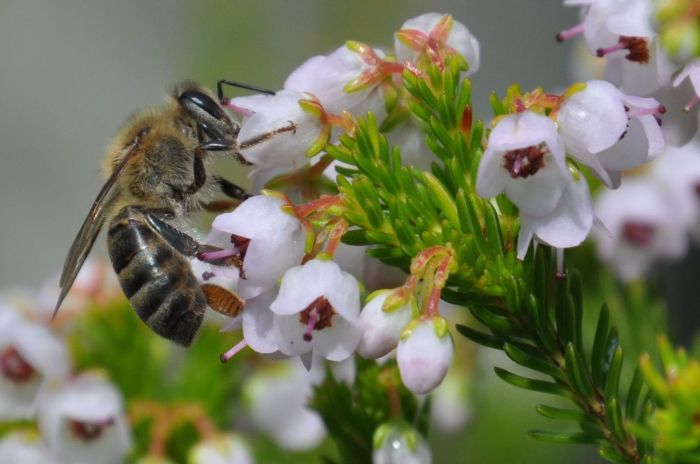Erica curvirostris
Erica curvirostris Salisb.
Family: Ericaceae
Common names: honey heath, honey-scented heath (Eng.); heuningheide (Afr.)
Introduction
A small shrub, covered with masses of small, pale pink, bell-shaped, honey-scented flowers in late summer and autumn, the driest time of the year in the Cape; it is perfect for fynbos gardens and it does well in containers.

Description
Description
Erica curvirostris is a compact, rounded, upright shrublet, 300 to 900 mm tall. The young branches are hairy. The leaves are small, in whorls of 4, narrow, 4–6 mm long, hairless. The flowers are presented in fours, sometimes in threes or in umbels, on hairy flower stalks (pedicels).

Flowers are small, 3.0 to 4.5 mm long; the corolla hairless, bell-shaped, pale to dark pink or white, and honey-scented. The style is usually curved and protrudes from the flower (is exserted). The anthers usually have a flattened, leaf-like appendage (are crested), which can be seen with a magnifying lens. The sepals are small, narrowly egg-shaped. The pedicel and sepals are often tinged with red. Flowering period is in late summer and autumn, from February to May.

Conservation Status
Status
Erica curvirostris has a stable wild population and is not considered to be of conservation concern, and is thus assessed as Least Concern (LC).
Distribution and habitat
Distribution description
Erica curvirostris grows in dry, stony areas, among rocks, on the mid to upper slopes of the mountains around and between Worcester, Paarl, Stellenbosch and Cape Town, in the Western Cape. It is found in the Du Toitskloof Mountains, Hottentots Holland Mountains, Kogelberg, Kleinrivier Mountains and Table Mountain. It is quite rare on the Cape Peninsula, where it occurs on Table Mountain and Constantiaberg.

Derivation of name and historical aspects
History
The genus Erica gets its name from ereiko, ‘to break’, either because of the ability of the plant to break up bladder stones or more probably because the stems are brittle and break easily. The species name curvirostris means ‘curved beak’, from Latin, referring to the curved style, although this is not a distinguishing feature as it is shared by other ericas.
Ecology
Ecology
Erica curvirostris flowers at the driest time of the year, and offers much-needed food for honey bees and other insects. At Kirstenbosch National Botanical Garden the flowers are worked by bees, which are the main pollinator.

Uses
Use
Erica curvirostris is not used in traditional medicine, nor is it one of the species commonly cultivated or sold as a cutflower, not because it does not last well in the vase, which it does, but because its stems are not long enough. It is an attractive garden ornamental and does well in containers.

Growing Erica curvirostris
Grow
Grow Erica curvirostris in a well-ventilated, sunny position, in well-drained, sandy, acidic soil. Feed with well-rotted compost applied as a mulch once or twice a year. Dilute or low doses of slow-release fertilizer can also be used. Pinching the tips on young plants results in a plant that is more branched, more compact and more floriferous. It is well suited to sunny rockeries, terraces, embankments and fynbos gardens in the winter-rainfall region. It is also suitable for containers.

Propagate by seeds or cuttings. Sow fresh seed in late summer to autumn (March–April–May). Treating the seed with Instant Smoke Plus Seed Primer will improve germination. Use a sandy, acidic, sterile medium. Because the seeds are very small, cover lightly or mix the seeds with some sand and cover the surface of the tray. Water with a fine rose and keep warm and moist. Germination takes a month or two, and seedlings are delicate. Transplant them when they are at least 10 mm high. Grow on in light shade until they are established.
Take semi-hardwood top or heel cuttings in late summer to autumn, or in spring. Treat with rooting hormone and place in well-drained, well-aerated, sterile rooting medium in a mist unit with bottom heating of ± 24°C. Pot the rooted cuttings in a well-drained, acidic soil medium and harden off in light shade for a month or two.
References
- Bean, A. & Johns, A. 2005. Stellenbosch to Hermanus. South African Wild Flower Guide 5. Botanical Society of South Africa, Cape Town.
- Foden, W. & Potter, L. 2005. Erica curvirostris Salisb. var. curvirostris. National Assessment: Red List of South African plants version 2017.1. Accessed on 202/04/28.
- Goldblatt, P. & Manning, J. 2000. Cape Plants. A conspectus of the Cape flora of South Africa. Strelitzia 9. National Botanical Institute, Pretoria & Missouri Botanical Garden, Missouri.
- Jackson, W.P.U. 1990. Origins and meanings of names of South African plant genera. University of Cape Town.
- Oliver, I. & Oliver, T. 2000. Field guide to the ericas of the Cape Peninsula. Protea Atlas Project, Cape Town.
- Schumann, D., Kirsten, G. & Oliver, E.G.H. 1992. Ericas of South Africa. Fernwood Press, Vlaeberg.
- Trinder-Smith, T., Maytham Kidd, M. & Anderson, F. 2006. Wild flowers of the Table Mountain National Park. South African Wild Flower Guide 12. Botanical Society of South Africa, Cape Town.
Credits
Alice Notten
Kirstenbosch National Botanical Garden
May 2020
Plant Attributes:
Plant Type: Shrub
SA Distribution: Western Cape
Soil type: Sandy, Loam
Flowering season: Late Summer, Autumn
PH: Acid
Flower colour: White, Pink
Aspect: Full Sun
Gardening skill: Average
Special Features:
Horticultural zones








Rate this article
Article well written and informative
Rate this plant
Is this an interesting plant?
Login to add your Comment
Back to topNot registered yet? Click here to register.